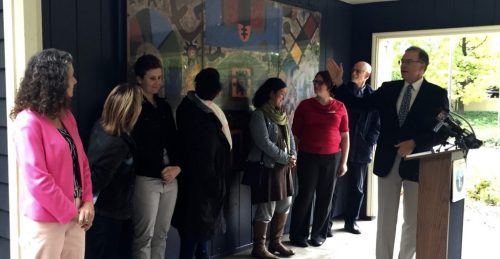Civil rights issues have intersected with restroom accessibility considerations for many decades.
Public restrooms have been a part of the United States' civil rights and gender conversation since they began to appear in modern public spaces in the early-1800s. An 1887 Massachusetts state law mandated the availability gender-segregated restrooms, which was considered a progressive win at the time because women were beginning to enter the workforce and face restroom availability discrimination based on gender. In present day society, however, these segregated restrooms are increasingly scrutinized for their lack of accessibility for those with non-binary gender identification and expression.
And it wasn't until the 1990 Americans with Disabilities Act that restrooms started to be constructed with disability access in mind. The facility modifications due to this national legislation have also benefitted those who need a larger space or additional support to use the restroom, including overweight persons, those who require assistance in using facilities, or families with small children.
In considering human rights and access to sanitation facilities, a growing number of municipalities/public sector agencies have upgraded their regulations to be more inclusive to all, regardless of their physical abilities, gender identity/expression, or body size.
The City of Portland, Oregon adopted an All-User Restroom Policy in November of 2015.

In November of 2015, Resolution 1339 was passed by the City Council in Portland, Oregon. Dubbed the "All-User Restroom Policy," this resolution stemmed out of an effort to remove inequities in restroom access revealed through surveys of City of Portland and Multnomah County employees. Testimony by members of Disability Rights Oregon served as a catalyst for a unanimous acceptance of the resolution by City Council. The resolution was initially introduced by the late City Commissioner Nick Fish, and its passing set in motion a careful action plan for upgrading and modifying the city's public restrooms to accommodate persons of all gender identities/expressions, persons of all body sizes, persons with physical disabilities, persons who may have personal attendants accompanying them in the restroom, and families with young children.
The first step in adopting this resolution was changing restroom signage to reflect "All-User" accessibility, and the next step was providing guidelines for construction of new facilities and the conversion of existing ones to accommodate all users. A ribbon-cutting ceremony for the first All-User Restroom occurred September 23, _2015 or 2016?__ at Dawson Park in North Portland. This ceremony was especially meaningful because only a few decades ago it was the site of segregated park toilets, underscoring the intersectionality and ongoing struggle for human dignity and basic rights we continue to face.
A listing of Portland-area parks with all-user accessible restrooms is available on the City website.
PHLUSH welcomes questions, comments, additions, and corrections to this listing.
Please contact us with any input.
Subscribe to our newsletter!
Newsletter Subscription
Why You Should Consider Making Your Restroom More Inclusive (And How To Do It) By Kip Earlywine (Used with permission from Green Flush Restrooms) It’s a beautiful day outside, so Dave decides to visit a new city park he hasn’t visited before. Upon arrival, he’s struck by the care and detail…
Research with MFA student Xinxiao Hui Public Pissour, or urinal, in Nyhavn, Copenhagen While Copenhagen may be listed as the fifth most densely populated city for public toilet per square kilometer in 2023, they are not always easy to find or accessible for all…
Research with MFA student Keliang Li Pee Curl, or public urinal for men, in Amsterdam On a recent trip to Amsterdam, when I asked a local shop owner where I could use the restroom, she told me there were plenty of places for men but…
Why You Should Consider Making Your Restroom More Inclusive (And How To Do It)
Public Toilets Case Studies with Pratt Institute: Copenhagen, Denmark
Public Toilets Case Studies with Pratt Institute: Amsterdam, Netherlands
[show_twitter_feed]
